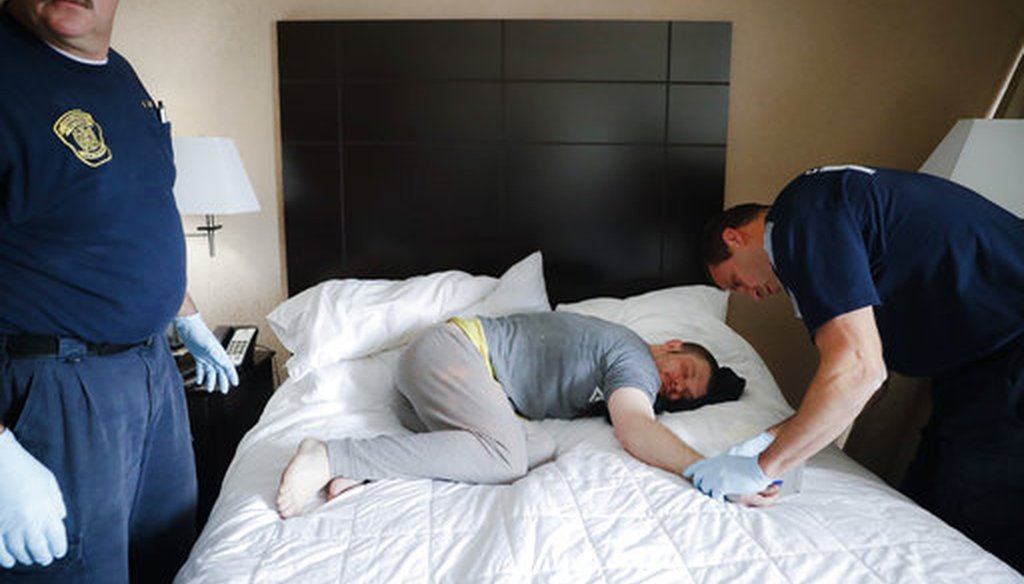Stand up for the facts!
Our only agenda is to publish the truth so you can be an informed participant in democracy.
We need your help.
I would like to contribute

In this Nov. 2, 2017, file photo, Cincinnati police officers, firefighters and medics respond to a possible overdose report at a hotel in downtown Cincinnati.(AP)
In 2017, opioid overdoses killed more than 47,000 people. It is a scourge that falls heaviest on white Americans, but no community or income group has been spared.
Recently, lawsuits against prescription drug makers and distributors, such as Purdue Pharma and Cardinal Health, have produced multi-billion dollar settlements. The legal action aims to hold industry players accountable for the amped up marketing and massive shipments of prescription painkillers that started in the mid-1990s and powered a wave of opioid addiction across the country.
But for all the deaths brought on by prescription opioids, the nation is now in what analysts call a third wave. The United States has moved from a health crisis driven by prescription drugs, to one driven by heroin, and now, by synthetic opioids, such as fentanyl, often smuggled from China.
Opioid addiction is a major public health crisis in battleground states, such as Pennsylvania, Michigan and North Carolina. President Donald Trump has vowed to "defeat this epidemic." Democratic candidate Sen. Elizabeth Warren, D-Mass., has a bill modeled on successful HIV-AIDS funding that would deliver a predictable stream of treatment and prevention money to states over the next 10 years.
Here are some of the key realities of the American opioid problem.
Sign up for PolitiFact texts
In the mid 1990s, Purdue Pharma began selling OxyContin, a slow-release pill based on the pain reliever oxycodone. Purdue Pharma funded more than 20,000 educational programs on managing pain. It gave money to professional associations, including the American Academy of Pain Medicine and the Federation of State Medical Boards.
In 20 years, between 1991 and 2011, the number of prescriptions tripled. At the same time, opioid-related deaths nearly tripled as well. With over 255 million prescriptions, the distribution peaked in 2012.
Prescription pain relievers continued to kill more people than other opioids for another few years, but heroin use was skyrocketing. In 2015, heroin deaths surpassed those from prescription drugs.
But in less than a year, fentanyl and other potent synthetic opioids had eclipsed the death toll by the other two drugs. Deaths from heroin and painkillers leveled off at about 15,000 deaths a year. By 2017, the synthetic opioids were killing over 28,000.
When it comes to public health threats, the third wave with mounting deaths from fentanyl and its ilk is the opioid epidemic’s new form. But that doesn’t mean the original problem with prescription drugs has gone away.
"Illicit fentanyl is really affecting the eastern part of the United States," said senior scientist Andrew Kolodny of Brandeis University. "In the western states, the problem is still prescription opioids. Even though you see more caution in prescribing opioids, no country on earth prescribes as much as we do. We’re still creating many new cases of opioid addiction."
The decline in prescriptions is not universally seen as a good thing. Lawmakers such as Tennessee Repubican Sens. Lamar Alexander and Marsha Blackburn have argued that limits make it harder for people in pain to get the drugs they need.
Governments at every level have tried, with some success, to contain and reverse the opioid crisis.
The federal government gave states money to build prescription drug monitoring programs. Agents began to crack down on rogue doctors and pharmacies, also called pill mills. Congress reclassified the active ingredient in prescription painkillers — hydrocodone — to put it under tighter control.
In 2018, Medicare cut back on how much it would cover prescription painkillers, and the Drug Enforcement Administration lowered the cap on the amount of these drugs that manufacturers could produce.
The drop in the number of prescriptions speaks to the effectiveness of those efforts.
But the problem is so widespread, efforts to provide treatment to those in need can't seem to keep up.
While Washington has sent states nearly $2 billion since 2017, primarily to make treatment more available, a large gap remains. The 2018 National Survey on Drug Use and Health found over 2 million people who abused opioids.
The number who had received treatment was 516,000, about a fourth of those in need.
One hurdle is many people in less populated areas live far from a place to get treatment. In hard hit states such as Kentucky, rural residents might need to drive 25 miles to get to a clinic, and the same is true in New Hampshire and West Virginia.
The map above tracks the distance to clinics that use drugs such as buprenorphine to help people with opioid use disorder stay off of pills and heroin. Access to such clinics is central to effective treatment, Kolodny says.
"Many lawmakers think we need more beds, and we don’t," Kolodny said. "What addicts need is easy access to drugs like buprenorphine, regardless of their ability to pay."
Total federal spending on opioids has risen dramatically, from $3.3 billion in 2017 to $7.4 billion in 2018. In that time, the emphasis has been on treatment and prevention. The money grew from 18% of all federal spending on opioids to 28%.
Medicaid has emerged as a key factor, for both hospitals and treatment clinics.
Even as the number of people in hospitals for opioid-related problems grew, the percentage of uninsured visits was cut in half.
Medicaid helps pay for the medicines used to treat opioid abusers, spending $1.2 billion in 2018.
Medicare has also been important. By 2014, Medicare covered the largest number of hospital visits for opioid abuse –– over 15,000 –– and Medicaid wasn’t far behind with about 13,000. Private insurance covered about 9,000.
Drug makers and drug distributors have faced a barrage of lawsuits for creating and fueling the first wave of the opioid epidemic. A federal court in Cleveland, Ohio, became ground zero for a consolidated trial of more than 2,000 suits nationwide. The proceedings involve the pharmaceutical giants, such as Johnson & Johnson and Mallinckrodt Pharmaceuticals on the manufacturing side, and Walgreens, AmerisourceBergen, McKesson and Cardinal on the distribution and sales side.
Purdue Pharma, the firm that led the way in selling prescription opioids, was also caught up in the Cleveland trial. It has offered to settle for over $10 billion. As part of the deal, Purdue would declare bankruptcy to protect it from further claims.
A group of states, led by Massachusetts and Pennsylvania, aim to block that bankruptcy provision.
More settlement offers could be on the way. On Oct. 1, Johnson & Johnson settled a suit brought by just two Ohio counties for $20.4 million. A tentative settlement worth about $30 million with the same two counties is on the table from Mallinckrodt Pharmaceuticals.
Oklahoma is the other epicenter of painkiller lawsuits. The state sued Johnson & Johnson, among others, and in August, a judge ordered the company to pay the state $572 million.
The legal battles over who should be held accountable for launching the opioid crisis, and how much they should pay, continues.
CORRECTION: We previously reported an inaccurate number for overdoses from opioids in 2017. The story has been revised to reflect the correct estimate from the Centers for Disease Control and Prevention.
Our Sources
National Institute on Drug Abuse, Increased drug availability is associated with increased use and overdose, January 2018
Centers for Disease Control and Prevention, Drug Overdose Deaths in the United States, 1999–2017, November 2018
U.S. Drug Enforcement Administration, 2018 National Drug Threat Assessment, October 2018
U.S. Substance Abuse and Mental Health Services Administration, Treatment Episode Data Set, April 2019
U.S. Substance Abuse and Mental Health Services Administration, Guidance on clinical best practices using medication-assisted treatment to combat the opioid epidemic, Feb. 15, 2018
Centers for Disease Control and Prevention, Rural health, accessed Oct. 3, 2019
Congressional Research Service, Prescription Drug Monitoring Programs, May 24, 2018
Congressional Research Service, Legal Authorities Under the Controlled Substances Act to Combat the Opioid Crisis, Dec. 18, 2018
Congressional Research Service, The Opioid Epidemic: Supply Control and Criminal Justice Policy—Frequently Asked Questions, June 28, 2019
Centers for Disease Control and Prevention, Understanding the Epidemic, Dec. 19, 2018
Reuters, U.S. states fight back against Purdue's bid to halt opioid lawsuits, Oct. 4, 2019
AmfAR, Distance to Nearest Substance Abuse Facility providing MAT, 2017
Andrew Kolodny, Testimony before the U.S. Senate Committee on Homeland Security and Governmental Affairs, Jan. 17, 2018
Kaiser Family Foundation, Key Facts about Uninsured Adults with Opioid Use Disorder, July 15, 2019
U.S. Substance Abuse and Mental Health Services Administration, 2018 National Survey on Drug Use and Health, August 2019
Bipartisan Policy Center, Tracking Federal Funding to Combat the Opioid Crisis, March 2019
Purdue Pharma, Purdue Pharma Announces Agreement in Principle on Landmark Opioid Litigation Settlement, Sept. 16, 2019
Annual Review of Public Health, The Prescription Opioid and Heroin Crisis: A Public Health Approach to an Epidemic of Addiction, Jan. 12, 2015
Centers for Disease Control and Prevention, Vital Signs: Overdoses of Prescription Opioid Pain Relievers --- United States, 1999--2008, Nov. 4, 2011
Reuters, Cardinal Health warns ongoing opioid-related lawsuits to hit business, Aug. 20, 2019
Washington Post, Johnson & Johnson ordered to pay $572 million for its role in Oklahoma’s opioid crisis, Aug. 26, 2019
New York times, Johnson & Johnson Reaches $20.4 Million Settlement in Bellwether Opioids Case, Oct. 1, 2019
Pew Trusts, Opioid Money Has Helped, But States Want More, Jan. 30, 2019
Centers for Disease Control and Prevention, Opioid basics, Dec. 19, 2018
Centers for Disease Control and Prevention, Drug Overdose Mortality by State: 2017, Jan. 10, 2019
JAMA Forum, Making Amends for the Opioid Epidemic, March 7, 2019
Vox, The thousands of lawsuits against opioid companies, explained, Sept. 11, 2019
Interview, Andrew Kolodny, Co-Director of Opioid Policy Research, Heller School for Social Policy and Management, Brandeis University, Oct. 4
Email exchange, Amanda Latimore, Assistant Scientist, Johns Hopkins School of Public Health, Oct. 4, 2019


















































